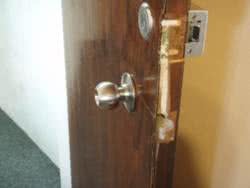In older Strata Scheme buildings, the query often arises regarding Asbestos exposure risk issues to be considered when replacing door handle sets, or undertaking door repairs associated with older Fire Doors.
In such cases, a fire services company is often engaged who selects two random unit doors for asbestos testing. They normally remove the door latch sets to obtain an asbestos sample, then send the sample to a regulatory laboratory for a confirmation test of the door core. The repair methods then proposed for the doors will differ depending on the door Asbestos test results, as there are different guidelines and maintenance issues associated with asbestos fire doors.
Legislation and Exposure Standards on the Use of Asbestos
From 31 December 2003 it was made illegal to use, re-use or sell any products containing any form of asbestos in Australia.
Although the ban does not apply to asbestos products that are already in place, but when they are replaced, non-asbestos alternatives must be used.
Fire Doors Explained
A fire door is a type of door, or closure used as a passive fire protection item within buildings to prevent the spread of fire. It is usually the only means of allowing people to pass through a fire-resistance rated wall assembly.
Components – Fire doors are made of a combination of materials, such as: steel / gypsum (as an endothermic fill) and or vermiculite-boards. Together, these components form a system which holds the rating. Apart from the door leaf, there is the doorframe, the door hardware and the structure that holds the fire door assembly in place.
Combustibility– Fire doors are not necessarily all non-combustible. A fire door is but one of many passive fire protection components used to compartmentalise fire and thus keep it in the compartment of origin, so either it runs out of fuel or it is extinguished, or, at the very least, enough time has been bought to enable the evacuation of the building.
Defeating fire doors– Fire doors are routinely defeated by unwise actions and apathy on the part of their users, many of whom paint over and/or ignore the product certification markings that are prominently displayed both on the door leaves and all the fire door frames, as well as by blocking them open. Such extreme neglect is the legal responsibility of the building owner (ie. Owners Corporation), who must educate occupants on the safe use of all safety related items, to ensure compliance with the fire code.
Normal operation– Most fire doors should be kept closed at all times, however some are designed to stay open under normal circumstances, only to shut automatically in the event of a fire.
Legislative Requirements
The door must be capable of achieving a minimum of 1 hour fire rating and be installed and maintained in accordance with the relevant Australian Standard being AS1905 & AS1851-2005. An approved fire-resistant door set is one that is identical in assembly, construction and installation to a prototype of this door that has been submitted to the standard fire resistance test, and has fulfilled all the relevant test requirements. A fire door must be self-closing or close automatically on the operation of an approved sensing device or on the loss of power supply. Each fire door must have a metal tag attached as required by AS 1905.1, 2005, and latch sets and closers should also be marked as required.
For further information regarding asbestos within Fire Doors, please contact ERMA Fire on (02) 9280 0030.
Please contact Shane Ball [email : admin@precisionstrata.com.au ] Licensed Strata Manager and Managing Director at PRECISION STRATA for assistance with your strata scheme management needs.

